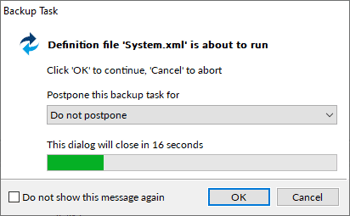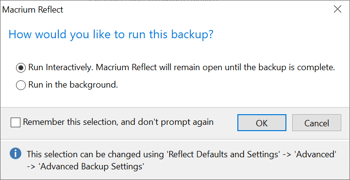- Priority
- Language
Priority
The CPU priority level updates the process and thread priority for the currently running backup, clone, and restore. The lowest level will allow other processes on your system to use CPU cycles in preference to the running backup, whereas the highest priority may cause other processes to wait for available CPU time. Lower priorities may result in Reflect processes taking longer to complete, but may also reduce the impact of performing a backup, clone, or restore on other running processes.

Log File Purge
This page of the 'Advanced Settings' can be used to control how long logs are retained, what happens to deleted logs, and purge logs immediately.

| Option | Description | |
| Purge Log File Settings | This section controls how long .html and .vss log files created by backup, clone, and restore operations are retained. These logs are viewed in the 'Logs' tab of Reflect. | |
| Remove older than X Days/Weeks | Specifies the amount of time that logs are retained before being purged. This can be specified as days or weeks. | |
| Move to the recycle bin | Deleted log files are moved to the recycling bin instead of being permanently deleted immediately. | |
| Perform at startup/Remove Now | Logs that are older than the specified amount of time in the 'Remove older than X Days/Weeks' setting are purged automatically when Reflect starts. If this is disabled, logs will not be purged until the 'Remove Now' option is used. | |
| Purge Schedule History Setting | This section controls how long the 'History' events associated with scheduled tasks are retained. These are viewed in the 'History' tab under the 'Scheduled Backups' tab. This only applies when the Macrium Task Scheduler is being used as described here. | |
| Remove older than X Days/Weeks | Specifies the amount of time that logs are retained before being purged. This can be specified as days or weeks. | |
| Perform at startup/Remove Now | Logs that are older than the specified amount of time in the 'Remove older than X Days/Weeks' setting are purged automatically when Reflect starts. If this is disabled, logs will not be purged until the 'Remove Now' option is used. | |
Advanced Backup Settings
This page specifies advanced options for disk images and file and folder backups.

| Option | Description |
| Ignore bad sectors when creating images |
By default, an image will fail when a bad sector is read from the source disk. When this option is selected, the image will continue when a bad sector is found. This may result in corrupt data when restored. |
| Log each bad cluster detail | When selected, bad sectors will be included in the log file. |
| Display backup notification delay for X seconds (range of 0 to 60) |
Configure how long the 'Backup Task' delay window is displayed before a scheduled task starts:
Selecting 'Do not show this message again' will uncheck the default setting configured here. |
| Do not abort file and folder backup if root folder is missing | When enabled, file and folder backups will continue, even if a root folder specified in the backup definition is missing. |
| Enforce entered image or file and folder backup file name |
By default, when an incremental or differential image runs, the destination folder is searched for a backup of the same source partitions (for example, when imaging the C: drive, the destination drive is searched for images containing the same source partitions in this example the C: drive), the newly created differential or incremental image is appended to the existing backup set and the specified file name of the newly created differential or incremental is ignored. The same principle applies for file and folder backups, whether or not a file and folder backup appends to existing backups in the destination is controlled on the 'Backup Set Matching' page of the 'Backup Defaults'. When 'Enforce entered image or file and folder backup file name' is selected only backup sets using the same backup file name and of the same source will be appended to. |
| Show a warning in the log if retention rules remove all backups in the destination folder |
If enabled, and all backups in the destination folder are deleted due to retention rules set before the backup started or the free space threshold is reached, then a warning message is shown in the log and the backup completes with a warning status. Note: The Warning will not be triggered if the Retention rules are explicitly set to retain 1 Full image and set to run before the backup. In this case, it is expected that there will be no backups before the current backup runs. |
| Only allow Administrators to monitor running backups | For multi-user systems, for example, terminal servers, ReflectMonitor will not run for non-administrator accounts if selected, preventing non-administrator users from monitoring the progress of operations. |
| Backup execution mode |
By default, execution is set as 'Prompt' which means an option dialog is prompted whenever users try to run an existing backup definition file via the 'Run Now' option. Changing this option to 'Interactive' or 'Background' makes the backup run interactively or in the background without prompting the user to choose.
|
| Report transfer rate in |
This option is used to change the way transfer rates are reported between bits per second and bytes per second (e.g. Mb/s and MB/s).
|
Advanced Incrementals

Enable Delta Indexes for Incremental Backups
The index is the part of the backup file that contains metadata, including keeping track of the data that exists in the backup set. There are two types of indexes that can be used by Macrium Reflect, full indexes and delta indexes.
When a full index is used, each incremental backup will have a full copy of the index, including references to where the most up-to-date version of data exists in the backup set.
| Advantages of full Indexes | Incrementals are self-describing | No additional backup files are required to be loaded other than the most recent Incremental when appending to an existing backup set. This enables backup sets to be "split" over multiple locations; useful if you want to archive part of a backup set. |
| Mounting incremental backups is fast | Because the entire index is available when the Incremental file is opened the backup set can be mounted and browsed in Windows Explorer very quickly. | |
| Disadvantages of full indexes | Increases the size of incremental backups | When running incremental backups on a data set where very little has changed the overhead of the full index may be greater than the size of the data that is backed up. |
| Consolidation causes subsequent incrementals to be updated | If your backup retention rules invoke a 'Synthetic Full' or 'Incremental Merge' then indexes contained in more recent incrementals are updated to reflect the consolidation. Without updating, the index would become "stale". This file change can cause excessive file copying when synchronizing consolidated backup sets to an archive location. |
Delta indexes differ, in that they only reference the data contained within its incremental backup. As a result, in order to create a full picture of the data contained in the backup set, each previous incremental and its delta index must be loaded:
| Advantages of delta indexes | Decreases the size of incremental backups | The incremental file index contains only a list of the changed data blocks in the incremental file itself. This means that incremental backups with only a few changes are optimized for backup file size. This is most apparent when performing frequent incremental backups. |
| Later incrementals are unaffected by consolidation | Because the incremental index only contains references to itself, there is no need to update the incremental backup file when earlier backups in the same set are consolidated. This overcomes the issue with backup folder synchronization caused by full indexes. | |
| Disadvantages of delta indexes | Incrementals depend on all previous backups | A backup set cannot be appended to unless all previous files in the set are available in the same folder as the most recent incremental. As a result, partial archiving of backup sets is not possible. |
| Mounting incremental backups may be slower | Because the full index has to be constructed when the incremental file is opened, this can lead to a delay of a few seconds when browsing backups in Windows Explorer. |
Enable Changed Block Tracking for Incremental Backups
Macrium Changed Block Tracker (CBT) will track the changes that occur to a file system in real-time and keep a record of the blocks that have changed. This reduces the amount of time taken to create incremental and differential images, as Macrium Reflect will not need to determine the changed blocks at backup run time.
Read more about Macrium Changed Block Tracker here.
Disable Incremental Consolidation
If consolidation is disabled and incremental retention is applied to a backup set, incremental backups are only deleted if doing so will not break the backup chain.
When this setting is enabled, it will be reflected in the backup log:

In the example below, there are seven incremental backups, five of the backups are appended to the full backup, and two incremental backups are appended to the differential. The retention rules have been set to retain 3 incremental backups:
| Full | Inc 1 | Inc 2 | Inc 3 | Inc 4 | Inc 5 | Diff | Inc 6 | Inc 7 |
With consolidation disabled, there are currently seven incremental backups, as applying any retention rules to the incremental backups would break the chain of dependencies in the backup set.
When an eighth incremental backup is created, the retention rules can safely purge incremental backups 1- 5 without any dependencies being broken for the three remaining incremental backups:
| Full | Diff | Inc 6 | Inc 7 | Inc 8 |
Intra-Daily Backups
Intra-daily backups can generate frequent and often unnecessary interruptions and log activity. This page of the settings can be used to change the logging and reporting behaviour of intra-daily backups to reduce unnecessary logging and notifications.
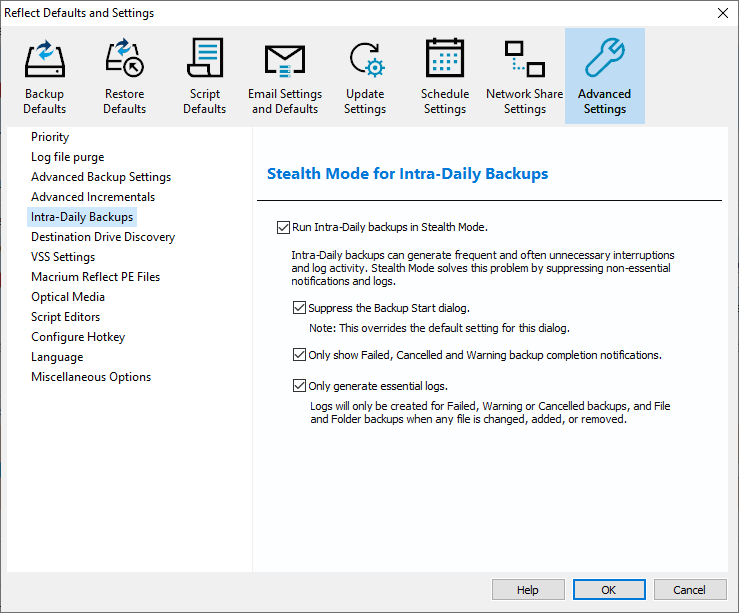
| Option | Description | |
| Run Intra-Daily backups in Stealth Mode | Supress the Backup Start dialog | When enabled, the 'Backup Task' delay window will be suppressed when scheduled intra-daily backups take place. |
| Only show Failed, Canceled and Warning backup completion notifications | Successful backups will not be displayed as a Windows toast notification. A toast notification will only be displayed for failed, canceled, and warning backups. | |
| Only generate essential logs | Successful backups will not generate backup log files in Reflect. Log files will only be created for failed, canceled, and warning backups. | |
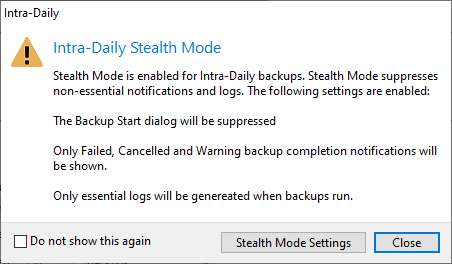
Destination Drive Discovery

| Option | Description |
| Use the assigned drive letter to locate the backup drive (default) |
The drive letter in the destination path is used exclusively to locate the backup destination. The destination path is saved in the format: 'X:\ExampleFolder' This enables multiple backup drives to be used in rotation, assuming that Windows assigns the same drive letter to each drive. |
| Use the unique volume identifier to locate the backup drive |
The unique volume identifier associated with the backup drive is saved in the backup definition file and used to locate the destination path. The destination path is saved in the format: '\\?\Volume{GUID}\ExampleFolder\' This enables Windows to assign a different drive letter to the same drive and the new letter will be automatically chosen as the backup destination. This is particularly useful for systems where drive letter assignment changes frequently. |
If this option is changed to 'Use the unique volume identifier to locate the backup drive', existing backup definition files should be edited and re-saved to update the XML file to contain the destination GUID.
VSS Settings
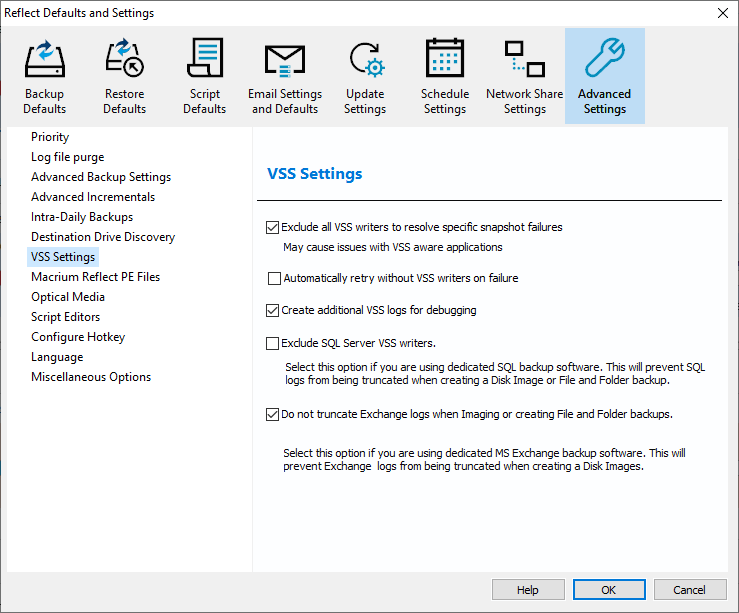
| Option | Description |
| Exclude all VSS writers to resolve specific snapshot failures |
This option will disable VSS writers. Due to Windows system configuration issues, VSS writers can cause backup failures. This option can cause issues for VSS-aware applications that rely on VSS writers to make their data consistent for snapshot creation. |
| Automatically retry without VSS writers on failure | If a backup experiences a VSS error during snapshot creation, Macrium Reflect will attempt to create the image again without using VSS writers. |
| Create additional VSS logs for debugging | Each backup will create additional VSS logs that can be used in order to troubleshoot VSS-related issues when creating backups. |
| Exclude SQL Server VSS writers (Macrium Reflect LTSC Server and Server Plus Only) | Select this option if you are using dedicated SQL backup software. This will prevent SQL logs from being truncated when creating disk images or file and folder backups. |
| Do not truncate Exchange logs when Imaging or creating File and Folder backups | Select this option if you are using dedicated Microsoft Exchange backup software. This will prevent Microsoft Exchange logs from being truncated when creating disk images or file and folder backups. |
Macrium Reflect PE Files
By default, the files that are used to create and boot rescue media are saved to the 'C:\boot\macrium' directory. A more desirable drive can be selected on this page, the PE files will subsequently be stored in a '\boot\macrium' directory created on the selected drive:
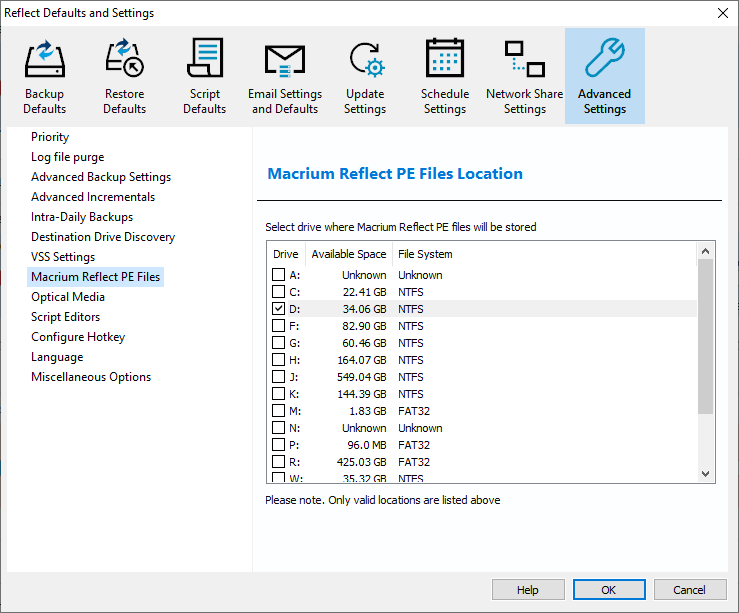
Optical Media

| Option | Description |
| Disable CD/DVD drive enumeration | CD/DVD burners that fail to return from a query request may cause an application hang. Select this option as a troubleshooting step if Macrium Reflect hangs on startup. |
| Create CD Engine log file |
Turning this option creates a log file that can be used for troubleshooting CD/DVD burner connection activity. The log file can be found at 'C:\HPCDE.log'. |
Script Editors
This page of the 'Defaults and Settings' can be used to control the program that is used when editing VBScript, PowerShell, MS-DOS batch, and XML files:
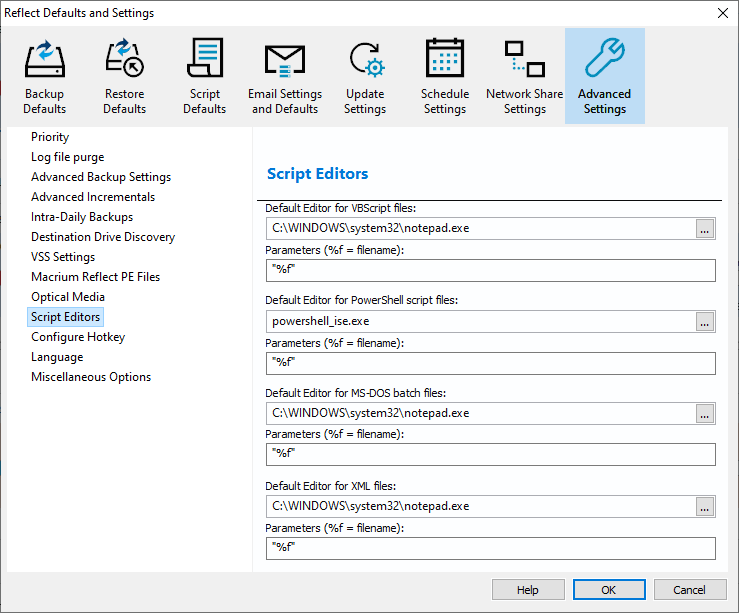
Configure Hotkey
ReflectMonitor is a standalone application that is used to monitor the progress of backups and cancel in-progress backups. ReflectMonitor can be easily launched using the default key combination of CTRL + ALT + M. In the event that third-party applications are already using the key combination, the letter used as part of the hotkey can be changed here. The hotkey can also be disabled:

Language
The language of the Macrium Reflect user interface can be changed on this page.

If the language is changed here, Macrium Reflect will restart to load the new language.
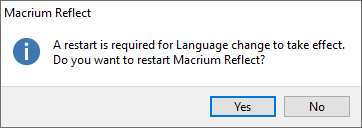
Windows PE/RE rescue media will be built using the chosen language at the time of media creation. If the language is changed, existing rescue media should be recreated to include this change.
Miscellaneous Options
The 'Reset' button on this page can be used to re-enable all dialogs hidden by selecting the 'Do not show this again' check box.
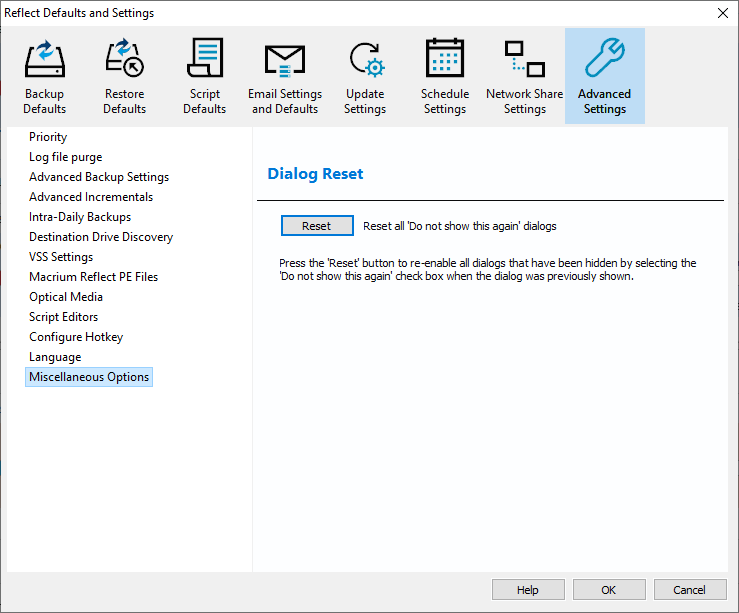
An example of a dialog that may have been hidden with the 'Do not show this again' checkbox is shown below:

